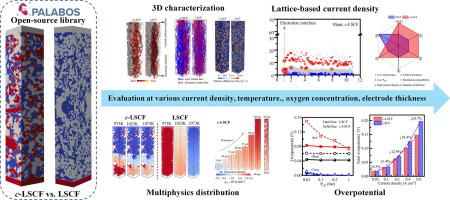Chemical Engineering Journal ( IF 15.1 ) Pub Date : 2023-06-02 , DOI: 10.1016/j.cej.2023.143854 Yuhua Wu , Zilin Yan , Jiawei Xu , Zheng Zhong , Xinhai Xu

|
Composite engineering is one of the most practical strategies for mitigating thermo-mechanical instability in state-of-the-art cobalt-based mixed ionic-electronic conducting electrodes for solid oxide cells. Nevertheless, the mechanism underlying improved performance and durability of composite electrodes is not substantially examined and understood. Pore-scale modeling can effectively bridge the gap between material property, microstructure discovery, and performance evaluation. However, most of the previous pore-scale models are built on in-house codes or commercial software that is closed-source to the public, limiting customization and community involvement. Here we report for the first time a microstructure-resolved 3D pore-scale model based on an open-source Lattice Boltzmann library, implementing a well-validated electrochemical module that considers gas, ion and electron transport, as well as electrochemical reaction at triple-phase-boundary (TPB) and double-phase-boundary (DPB). The pure La0.6Sr0.4Co0.2Fe0.8O3-δ (LSCF) and 50/50 vol% composite LSCF/GDC (Gd-doped ceria) cathodes are reconstructed using focused ion beam-scanning electron microscopy and then are investigated under various current densities, temperatures, oxygen concentrations, and thicknesses. Results reveal the advantages of boosted TPB density and ionic conductivity outweigh the disadvantages of lower DPB density and electronic conductivity for the composite cathode. Furthermore, the composite cathode performs better at low temperatures and low oxygen concentrations due to the presence of more macropores, the stable bulk ion conductivity of GDC, and higher TPB density. Local current distribution at active sites indicates a thickness of 20 to 40 μm is favorable for reduced overpotential and moderate reaction homogeneity.
中文翻译:

通过一种新的开源孔尺度模型洞察固体氧化物燃料电池混合导电复合阴极中促进氧还原反应的机理
复合工程是减轻用于固体氧化物电池的最先进的钴基混合离子电子导电电极中热机械不稳定性的最实用策略之一。然而,复合电极性能和耐久性提高的潜在机制尚未得到充分研究和理解。孔隙尺度建模可以有效地弥合材料特性、微观结构发现和性能评估之间的差距。然而,大多数以前的孔隙尺度模型都是建立在内部代码或商业软件上的,这些软件对公众是封闭源代码的,限制了定制和社区参与。在这里,我们首次报告了基于开源格子玻尔兹曼库的微观结构分辨 3D 孔隙尺度模型,实施经过充分验证的电化学模块,考虑气体、离子和电子传输,以及三相界面 (TPB) 和双相界面 (DPB) 的电化学反应。纯粹的拉0.6 Sr 0.4 Co 0.2 Fe 0.8 O 3-δ(LSCF) 和 50/50 vol% 复合 LSCF/GDC(掺 Gd 二氧化铈)阴极使用聚焦离子束扫描电子显微镜重建,然后在各种电流密度、温度、氧浓度和厚度下进行研究。结果表明,对于复合阴极而言,提高 TPB 密度和离子电导率的优势超过了较低 DPB 密度和电子电导率的劣势。此外,由于存在更多的大孔、GDC 稳定的体积离子电导率和更高的 TPB 密度,复合阴极在低温和低氧浓度下表现更好。活性位点的局部电流分布表明 20 至 40 μm 的厚度有利于降低过电势和适度的反应均匀性。


























 京公网安备 11010802027423号
京公网安备 11010802027423号